I've been trying to create a tileset generator (blending two images together) but I'm stuck at what kind of method I need to be able to make one texture/image overlap onto the main one, or somehow fade out at specific points - or is this something that can't be done (or shouldn't be done) automaticaly?

With the green image fading out, the blue image should fade in on top of the green image to make a smooth transition. If I have two images already - how can I do this?
Right now, I can only cut out the part that's blue. So the only part left is green, when I've tried adding an overlay it's just simply ugly and I suppose the alpha levels should increase (the blue should get more blue the closer you are to the Bottom Right corner).
Any ideas what I should be looking at?
My current method: But currently, this only works with one corner but should work with "all" corners; can't figure out what's causing it.
public static Bitmap GenerateTile(Bitmap bitmap, Bitmap copyFrom, int x, int y, int width, int height, Point[] cutoff)
{
if (bitmap.Size != copyFrom.Size)
throw new Exception("Invalid image size. Image sizes must match");
Bitmap bmap = new Bitmap(width, height);
Bitmap overlay = new Bitmap(width, height);
Point min, max;
float alpha;
// returns minimum x, y and maximum x, y
GetCorners(cutoff, out min, out max);
for (int bx = x; bx < (x + width); bx++)
{
for (int by = y; by < (y + height); by++)
{
if (!IsInPolygon2(cutoff, new Point(bx, by)))
{
bmap.SetPixel(bx, by, bitmap.GetPixel(bx, by));
}
else
{
alpha = ((float)((max.X - bx) + (max.Y - by)) / (float)((max.X - min.X) + (max.Y - min.Y)));
if (alpha >= 0 && alpha <= 0.5f)
{
bmap.SetPixel(bx, by, Color.FromArgb((int)((alpha / 0.5f) * 255f), bitmap.GetPixel(bx, by)));
overlay.SetPixel(bx, by, Color.FromArgb((int)(255f - ((alpha / 0.5f) * 255f)), copyFrom.GetPixel(bx, by)));
}
}
}
}
using (Graphics g = Graphics.FromImage(bmap))
{
g.DrawImageUnscaled(overlay, 0, 0);
}
return bmap;
}
My method returns the following results (not good yet):

// bottom right corner
points.Add(new Point(image.Width / 2, image.Height));
points.Add(new Point(image.Width, image.Height / 2));
points.Add(new Point(image.Width, image.Height));
points.Add(new Point(image.Width / 2, image.Height));
// rightside
points.Add(new Point(image.Width / 2, image.Height));
points.Add(new Point(image.Width, image.Height));
points.Add(new Point(image.Width, 0));
points.Add(new Point(image.Width / 2, 0));
points.Add(new Point(image.Width / 2, image.Height));